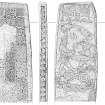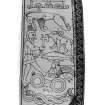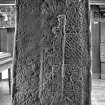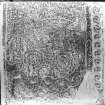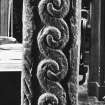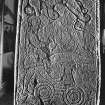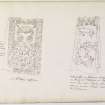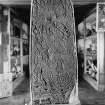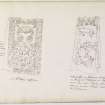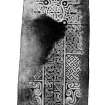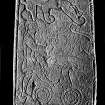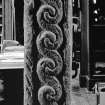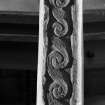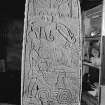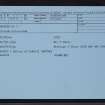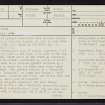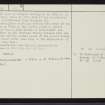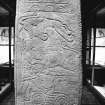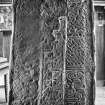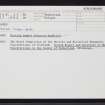Golspie
Cross Slab (Pictish), Pictish Symbol Stone (Pictish)
Site Name Golspie
Classification Cross Slab (Pictish), Pictish Symbol Stone (Pictish)
Alternative Name(s) Craigton
Canmore ID 6564
Site Number NC80SW 13
NGR NC 837 002
Datum OSGB36 - NGR
Permalink http://canmore.org.uk/site/6564
- Council Highland
- Parish Golspie
- Former Region Highland
- Former District Sutherland
- Former County Sutherland
Golspie 1 (St Andrew), Sutherland, Pictish cross-slab with ogham inscription
Measurements: H 1.83m, W 0.81m, D 0.15m
Stone type: purple sandstone
Place of discovery: NC 837002
Present location: Dunrobin Museum (ARC 527), Dunrobin Castle.
Evidence for discovery: first recorded by Cordiner in 1776 in the graveyard at Golspie, where it had been re-used as a recumbent graveslab for a seventeenth-century burial. The church at Golspie had been the parish church since 1619, and the eighteenth-century church was built on the site of the medieval St Andrew’s Chapel built by the Sutherland family. Stuart recorded it upright in the graveyard at Golspie around 1850. In 1868 it was taken to Dunrobin Museum.
Allen seems to have been misinformed that it spent the 1840s at Craigton. Mack argued that it came from Culmaily Kirkton (2007, 59-60), on the grounds that there was more likely to have been an ecclesiastical site there in Pictish times than at either Golspie or Craigton, but there may well have been an earlier church on the site of St Andrew’s at Golspie. It is also possible that the cross-slab stood alone in the landscape at Golspie.
Present condition: most of the surface damage is confined to face A, where re-use led first to the obliteration of carving around the edge of the slab and later to extensive damage and wear to part of the shaft and the ornament to the left of the shaft.
Description
This impressive slab is carved in relief on faces A, B and D and in incision on face C. Face A bears a cross outlined by a roll moulding, with a central roundel, squared terminals to the arms and almost closed small circular armpits. The roundel contains knotwork forming a cross, and the shaft is similarly filled, creating a series of embedded crosses. The arms are filled with interlace, as are the background spaces between them. Below the arms and flanking the shaft are panels of zoomorphic interlace, diagonal key pattern and spiral pattern, and the base of the shaft sinks into a large panel of diagonal key pattern.
Faces B and D are both carved with a single narrow panel containing running scrolls in relief, that on face D ending short of the base of the slab to match the carving on face C.
Face C is incised with four large and four small symbols, with the addition of a pair of entwined serpents but no hunting scenes, which Henderson and Henderson described as ‘conscious archaism’ (2004, 70). At the top is a large and ornate rectangle, with spirals extending from the corners. There is a small gap between the rectangle and the Pictish beast below it, whereas all the other designs are firmly touching one another. The snout of the beast touches the head of a formidable man symbol below. This bearded figure with prominent nose strides to the right, dressed in a short belted tunic with long sleeves. In his left hand he grasps a knife ready to stab, and in his right hand a battle-axe ready to strike. The blade of the axe touches the snout of an animal, which Thomas argued represents a wild cat (1994). The animal’s tail curves over its back and the joints at the top of its legs are shown with spirals. It stands on a fish, which touches the flower symbol below, and there is a small crescent and V-rod symbol to the right of the flower. Below again is a large double disc, each disc formed of three concentric circles, and at the bottom of the slab two horizontal entwined serpents, each biting the other’s fish-like tail, one ornamented with a zig-zag line and dots and the other with a median line. The small spaces between the two serpents have been hollowed out to resemble relief carving. Probably secondary to all this carving is an incised line running all round the visible face, which creates a roll moulding on which an ogham inscription has been inscribed up the right hand edge and along the top, continuing over to the adjacent face in such a way that the edge of the slab becomes the base line for the ogham letters. The inscription reads ALL HALLORREDD M[E]QQ N[IA] V[ARRCERR], of which a likely interpretation is ‘the monument of Alored son of NiaFercar’ (Forsyth 1996, 318).
When it was re-used as a recumbent the early medieval carving was almost entirely removed in a band round the perimeter of face A, in order to add the inscription: ‘Heir is the burial pleac of Robert Gordon eldest son to Alex Gordon of Suther[land]’. There is no date unfortunately, indeed the inscription may be unfinished, but the Gordon family was certainly living nearby at Dunrobin Castle in the seventeenth century.
Date: eighth or ninth century.
References: Cordiner 1780, 72; Stuart 1856, 12; ECMS pt 3, 48-50; Thomas 1994; Forsyth 1996, 299-320; Henderson & Henderson 2004, 70; Fraser 2008, no 140.
Compiled by A Ritchie 2016
NC80SW 13 837 002.
A Class II upright cross-slab with incised symbols and Ogams, now in Dunrobin Museum, is said to come from Craigton (NH 78 98) (Stuart 1856), Culmaily (NH 80 99) (Information contained in letter from Miss M W Grant to J Close-Brooks, 21 October 1975), or Golspie (NC 83 00) (Information contained in letter from J Close-Brooks to OS, 21 October 1975).
It is a rectangular slab of purple sandstone, 6ft high, 2ft 8ins wide at the base, 2ft wide at the top, and 6ins thick, which bears on the front an interlace cross, carved in relief, surrounded by panels of interlacing. The back bears incised symbols enclosed by a roll moulding on whose top and right hand edges Ogams have been carved. The symbols consist of a decorated rectangle, an 'elephant', an armed man facing a 'wolf', the fish, flower, crescent and V-rod, and double disc and Z-rod symbols, and a pair of 'serpents'.
As to the original location, the most likely provenance for an 8th - 9th century Christian cross-slab would be a contemporary ecclesiastical site, and the only one known in the area is Kilmailie (NH79NE 5); but the stone may have been in Golspie churchyard in 1780 (Cordiner 1780; 1788) and was certainly there in 1856 when it had an attached tradition of transference from Craigton (Stuart 1856).
A late inscription which has defaced the front of the slab is given as "Heir is the burial place to Robert Gordon, eldest son to Alex Gordon of Sutherland" and obviously refers to the Dunrobin family between 1514 and 1766. Its date and the burial place of the Robert Gordon commemorated would offer some clue to the whereabouts of the stone at that time.
It was transferred from Golspie churchyard to Dunrobin Museum in 1868 (Accession no: 15/15A).
C Cordiner 1780; 1788; J Stuart 1856; J Anderson and J R Allen 1903.
New Acc. No: 1868.62 Metric measurements 1.83m x 0.82m x 0.17m. (to plinth)
Information contained in TS of Catalogue of Dunrobin Museum by A S Henshall.
Class II symbol stone.
(Undated) information in NMRS.




























